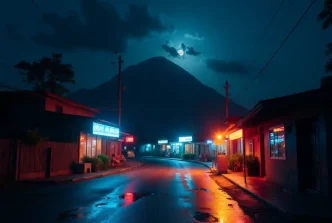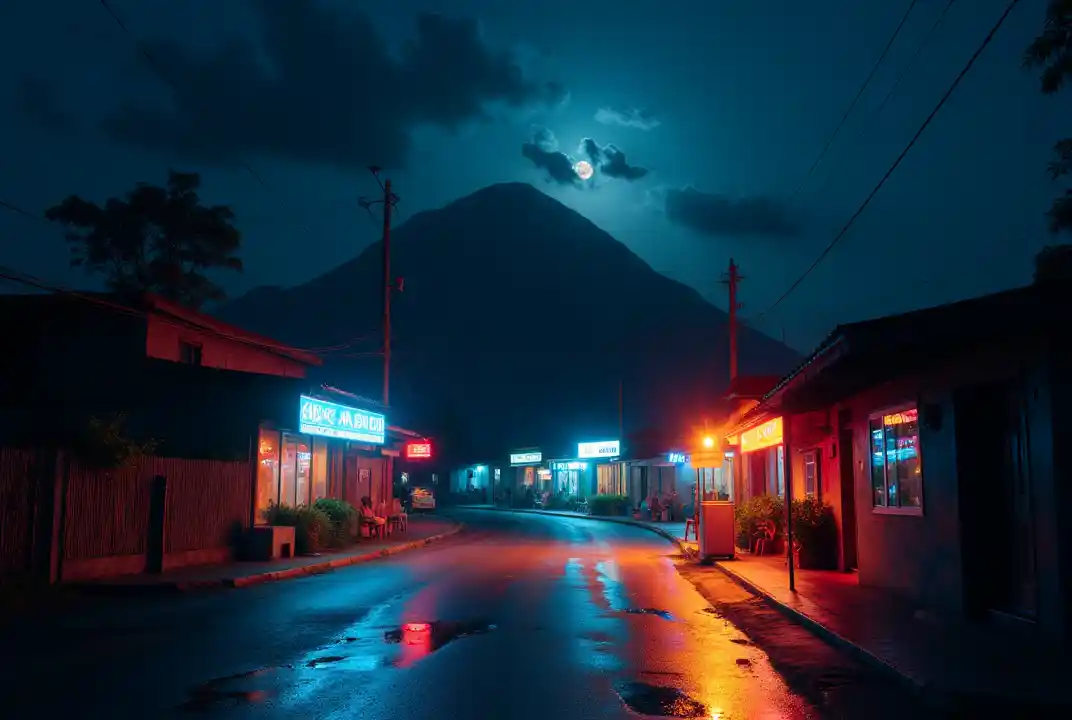A powerful eruption of Mt. Kanlaon on Negros Island early Tuesday morning has cast a shadow over communities in Negros Occidental and Negros Oriental, as thick ash clouds and sulfurous fumes enveloped towns and forced thousands to remain in evacuation centers. The third major eruption since June last year, this event has heightened fears of further volcanic activity, prompting local authorities to suspend classes and government work while the national government pledges support for affected residents.
A Morning of Fear and Darkness
At 5:51 a.m. on April 8, 2025, the skies over Negros Island darkened as Mt. Kanlaon unleashed a voluminous plume of ash and debris, rising at least 4 kilometers above its crater. The eruption, lasting nearly an hour until 6:47 a.m., sent ash drifting west and southwest, severely impacting areas like La Carlota City, Bago City, and La Castellana in Negros Occidental. Mayor Rhummyla Nicor Mangilimutan of La Castellana, the town closest to the volcano, witnessed the event from a building in Barangay Cabacungan. She described the sight as terrifying, with pockets of fire visible on the volcano’s slopes and winds carrying ash toward neighboring communities.
In La Carlota City, the worst-hit area by ashfall, residents like Bernie Rojo, a village council member in Barangay San Miguel, were left in shock. “When I went out of my house, I saw thick gray ash rising into the sky before it fell to the ground after about 10 minutes” he told local reporters. The intensity of the ashfall, coupled with strong sulfurous fumes in areas like Barangay Cubay, underscored the immediate threat to public health and safety.
The Philippine Institute of Volcanology and Seismology (Phivolcs) reported that pyroclastic density currents—dangerous mixtures of fragmented volcanic particles, hot gases, and ash—descended the southern slopes within a kilometer of the crater. Large ballistic fragments were also hurled near the summit, igniting vegetation and adding to the chaos. While the eruption was less intense than the major event on December 9 of the previous year, Phivolcs noted it lasted longer, with additional ash emissions observed into the early afternoon.
Impact on Communities and Infrastructure
Mt. Kanlaon, straddling multiple cities and towns across Negros Occidental and Negros Oriental, has long been a source of both awe and concern for local communities. Following eruptions in June and December of the previous year, over 2,612 families—amounting to 8,335 individuals—remain in evacuation centers across the two provinces. Tuesday’s eruption has compounded their plight, with no immediate timeline for return as volcanic unrest persists at Alert Level 3, indicating a “high level of volcanic unrest.”
Local governments moved swiftly to mitigate risks. Classes were suspended in several towns, including La Carlota, La Castellana, Pontevedra, Bago City, and Isabela, while Mayor Rex Jalandoon of La Carlota also halted work in government offices to prioritize resident safety. Civil aviation authorities were advised to reroute flights away from the volcano’s summit, as sudden ash emissions could pose significant hazards to aircraft. Manuel Lamata, a sugar industry leader, recounted a harrowing experience as his private plane took off from Bacolod-Silay Airport just as the sky darkened over Mt. Kanlaon. “It was very scary” he said, echoing the sentiments of many who witnessed the eruption.
The agricultural sector, a cornerstone of Negros Island’s economy, faces potential setbacks as ashfall blankets farmlands. Sugar cane plantations, a key industry in the region, may suffer reduced yields if the ash persists or if further eruptions occur. While no official estimates of economic damage have been released, the recurring nature of these volcanic events raises questions about long-term resilience for farmers and local businesses.
Scientific Warnings and Preparedness Efforts
Phivolcs, tasked with monitoring volcanic activity across the Philippines, has urged vigilance despite the absence of immediate signs of escalation, such as a spike in volcanic earthquakes. The current Alert Level 3, while serious, falls short of the highest Level 5, which would indicate a hazardous eruption in progress. Teresito Bacolcol, Phivolcs chief, emphasized the unpredictability of the situation in a statement to The Associated Press. “The possibility of a bigger eruption is always there” he said, advising residents to stay clear of the 6-kilometer danger zone surrounding the volcano.
Mari-Andylene Quintia, a Phivolcs resident volcanologist based in La Carlota City, noted that while Tuesday’s eruption was less intense than previous ones, its duration and secondary ash emissions signal ongoing instability. She highlighted the importance of preparedness, as local governments were advised to ready communities within the hazard zone for potential evacuation if conditions worsen. Phivolcs has also outlined multiple scenarios for Mt. Kanlaon’s activity, ranging from sustained unrest to a full-scale hazardous eruption, though no definitive predictions have been made.
On the national level, Malacañang has affirmed its commitment to supporting affected communities. Palace press officer Claire Castro announced during a briefing that President Marcos had directed the Department of Social Welfare and Development (DSWD) to coordinate closely with local government units (LGUs). “The DSWD is continuously giving provisions or family food packs and nonfood items to our affected countrymen” she said. Over 250,000 boxes of family food packs have been prepositioned in warehouses across Western and Central Visayas, a proactive measure to address the needs of displaced families amid the ongoing crisis.
Historical Context and Regional Vulnerability
The Philippines, situated along the Pacific Ring of Fire, is home to dozens of active volcanoes, with Mt. Kanlaon ranking among the most restless. Its history of eruptions dates back centuries, with significant events often disrupting life on Negros Island, a region known for its agricultural productivity and vibrant communities. The volcano’s location, spanning multiple administrative boundaries, complicates disaster response efforts, as coordination between Negros Occidental and Negros Oriental is critical to effective management.
Recent years have seen an uptick in volcanic activity at Mt. Kanlaon, with eruptions in June and December of the previous year displacing thousands and straining local resources. The psychological toll on residents, many of whom have endured repeated evacuations, cannot be understated. Families in evacuation centers face uncertainty about when—or if—they can return to their homes, while children miss out on education due to suspended classes. The recurring nature of these events has also sparked discussions about long-term relocation for communities within the permanent danger zone, though such measures remain politically and logistically challenging.
Beyond immediate safety concerns, the eruptions highlight broader vulnerabilities in the region. Infrastructure, from roads to utilities, often suffers under the weight of ashfall and debris, while public health risks—such as respiratory issues from ash inhalation—loom large. Local governments, while quick to respond, often lack the resources for sustained recovery efforts, relying heavily on national support and international aid in severe cases.
Looking Ahead: Uncertainty and Resilience
As Mt. Kanlaon continues to rumble, the people of Negros Island brace for what might come next. Scientists and authorities alike stress the importance of preparedness, with no clear end in sight to the current phase of volcanic unrest. For residents, the balance between vigilance and normalcy remains elusive, as each eruption serves as a stark reminder of nature’s unpredictability.
The national government’s swift pledge of assistance offers some reassurance, but questions linger about the sufficiency of resources for long-term recovery. Will agricultural communities rebound from repeated disruptions, and can infrastructure withstand further strain? As aid reaches evacuation centers and monitoring efforts intensify, the resilience of Negros Island’s people shines through, even in the face of an uncertain future.
















